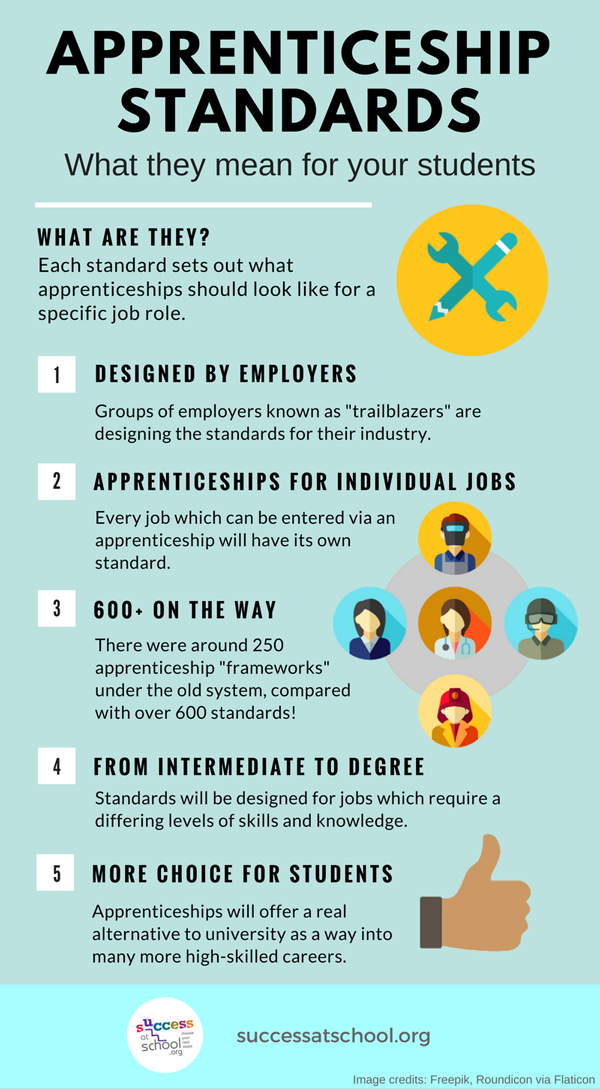Employers and Universities: Work with us?

What are apprenticeship standards?
If all this talk of apprenticeship standards has got you scratching your head, you’ve come to the right place.
In this guide, we talk you through the government’s changes to the way apprenticeships are delivered, and what this means for your students.
'The apprenticeship standards mean more choice for your students – get up to speed'
What are the apprenticeship standards?
An apprenticeship standard is a template for the way a specific apprenticeship is delivered. In the simplest terms, it outlines:
- What an apprentice will do during their apprenticeship.
- The skills they will need to perform the job role they’re training for.
The apprenticeship standards are new, and will replace the old system of frameworks.
For a quick overview of what the new standards mean for your students, have a glance at this infographic we made:

Why are they being introduced?
The new apprenticeship standards are being brought in following a review of the way apprenticeships were being delivered.
The review was commissioned by the Department for Business, Innovation and Skills (BIS) in 2012. It found that employers felt the old apprenticeship frameworks didn’t meet their needs. In other words, apprentices did not necessarily gain the skills, knowledge and experience they needed to do their jobs.
To solve this problem, the government decided that a new set of requirements for apprenticeships was needed. These are the apprenticeship standards.
How will the standards help?
The standards are being developed by groups of employers, known as “trailblazers”. As of December 2016, 1,200 employers were involved.
Each trailblazer group belongs to a particular industry, and is developing a standard for every job role in their industry which can be entered via an apprenticeship.
There will be separate standards for similar jobs which require differing levels of skills and knowledge, and have different entry requirements.
For example, within the food and drink industry, there are two similar sounding apprenticeships:
- Food and drink process operator
- Food and drink advanced process operator
The first is a level 2 (intermediate) apprenticeship, while the second is a level 3 (advanced) apprenticeship, but each has its own standard to ensure that the training is tied directly to the requirements of the specific job role.
This means the standards will be more rigorous than the frameworks they replace, because they will be tied to the demands of a specific job.
As part of the changes, every apprenticeship will have something called an “end-point review”, which will be set out in the standard. This is basically a standardised assessment designed to make sure that whoever an apprentice is training with, they will receive the same level of training as any other trainee on the same apprenticeship with any employer, anywhere in the country.
Any employer will be able to deliver an apprenticeship for a job role to the same degree simply by following the standard for that apprenticeship.
When will they be ready?
According to City & Guilds, the apprenticeship standards will be complete by 2020, although this date may change.
Many of them are already “approved for delivery” (you can download a list of them from this page of the GOV.UK website). This is techno-speak meaning that they have been drawn up by the trailblazers and signed off by the government, and are ready for employers to deliver whenever they like.
This doesn’t necessarily mean they are available for students to apply to right now.
How many apprenticeship standards will there be?
Lots! Probably between 600 and 800.
As we mentioned, many are still being drawn up, so we can’t put an exact number on it at the moment. We can say that there will be many more standards than there were frameworks under the old system, which numbered around 250.
Partly, this is because there will be a standard for each job role – but entirely new apprenticeships are being developed as well. That’s because the government is working with employers to turn apprenticeships into an attractive route into high-skilled work.
For example, as of December 2016, there were already over 25 apprenticeship standards relating to engineering approved for delivery. These were in fields as diverse as energy and utilities, rail engineering and TV production and broadcasting.
They spanned from intermediate, which typically functional skills and earns apprentices the equivalent of A-levels, all the way up to degree, which gain apprentices a university degree as part of their training.
Industries are also diverse, including a mix of popular – as well as some unusual – fields of work, such as:
- Accountancy
- Equestrian
- Fashion
- Food and drink
- Fire and rescue
- Video games
- Visual effects
All this equates to a huge amount of choice across a huge range of high-skilled and rewarding job roles for young people looking to go straight into the world of work.
Because apprenticeships offer training and qualifications as part of a paid job, apprenticeships are already a better way into high-skilled work than university for many students. We compare university with apprenticeships for young people who are struggling to make up their minds.
You might also like...
What are the different types of apprenticeships?
Top five apprenticeships in the UK
Image credits
http://www.freepik.com/free-vector/checking-task-list-by-hand_760718.htm
http://www.flaticon.com/free-icon/soldier_206879
http://www.flaticon.com/free-icon/welder_206882
